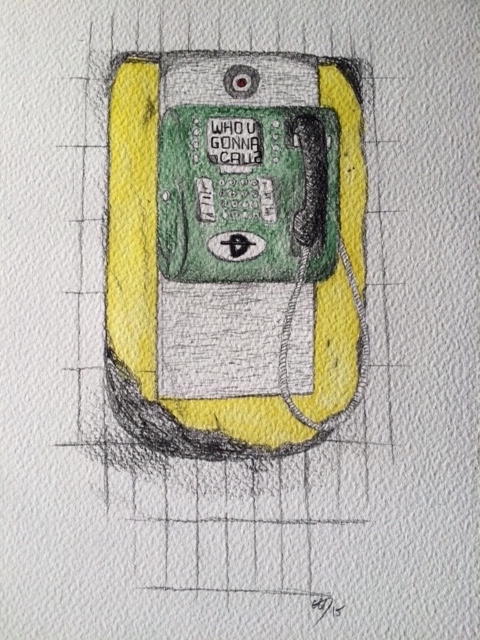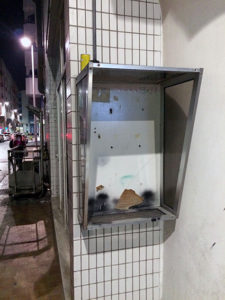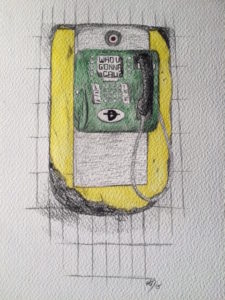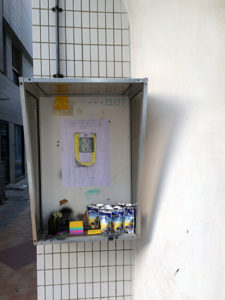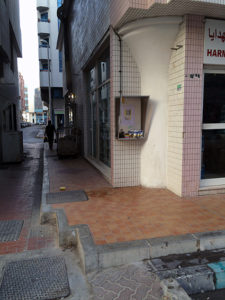Week 1: Art of the MOOC
Public Art and Spatial Politics: Social Method
Artist: Michal Teague
1. A description of the social response caused by this displacement as shown in the images.
There is an empty wall mounted phone booth where I live in Street 20, Old Water Tanker Area, in Abu Dhabi. The site is hot, humid and quiet. At night the street comes alive with 4WD’s double parked beeping horns outside the Syrian Restaurant, the Baqala (convenience stores) and Vipers Car Detailer. Here life revolves around cars and moving quickly from one air-conditioned building to another. (Images A and B).
I decided to replace a version of the old phone. (Image C). The act of putting art in the street is here a process of displacement in its self. Art is a luxury. The people are busy with families, bustling children on and off buses (if they are fortunate enough to have them living with them) or living cheaply remitting their money home to ensure the education and wellbeing of their children and extended family.
2. A description of your efforts to conduct the event, including any relevant
efforts that did not produce a result.
My ideal artwork would be to recreate a model of the telephone that would have originally been here using carved ice and document the process of it melting. This was not done due to budget and time constraints.
It is a challenge to interact socially and observe peoples’ responses. It is a custom to humbly avoid drawing attention to oneself, a collective rather than an individualistic view of culture. As a white western woman, I immediately stand out through dress and behavior. Displacement, indeed, for many is a way of life, this is a country where only 10% of the population counts as local in the census.
I approach the social warily, an introvert by nature, in this space, participative art can seem exploitative, making use of people when they simply wish to be unguarded and relax after work. For me the social needs to be deeper, reciprocal, longer term.
3. Briefly highlight and explain how at least three topics, artist or projects
mentioned in the lecture are directly related to your project.
Sophie Calle’s piece involving a phone booth replete with phone, snacks, notepaper and flowers. I was struck the technological difference that has occurred in the time elapsed since she made her work. Most of public phone booths in Abu Dhabi are now bereft of the phone, their reason for being.
Could I have a conversation over time and place with this work and how would the location of Abu Dhabi alter the response. The decommissioned booths devolve to become a dusty place to stash empty energy drink cans and bottles. Was the social interaction with the ghosts of people who once made calls from this place? The people living here often seemed to shy away.
Could I replace/displace the phone?
The snacks?
The notepaper?
Flowers?
Public phones are now the ghosts of a city dominated by cell/mobile phone technology. The public phone booth is a communication site where you can no longer connect. Who would the people call? Language is a barrier too. How to communicate in a diverse community that speaks Arabic, Urdu, Hindi, Tagalog, Bengali, Nepali, Sinhalese etc? English is the common language used but it’s not always easy to communicate with each other.
Another form of displacement is a lack of shared cultural references. Will the audience understand the movie and song reference from Ghostbusters?
“Who you gonna call?”
This is what I elected to do:
1. Draw the original phone. (Image C).
2. Provide drinks.
3. Ask people to write the name of the person they’re going to call.
4. Flowers.
For this assignment I used a mix of the handmade and readymades to promote simple interactivity with the viewers. Normally I prefer to be a maker so I was happy there was an element of drawing in the project. (Images C and D).
Tom Finkelpearl discusses cooperative art and the desire to build new audiences. I really appreciated his comment that projects tend to overclaim.
The art world in Abu Dhabi is limited and only accessible by a certain portion of the community. I have done one large cooperative work here, but I would like to find ways to more effectively engage the low income workers.

